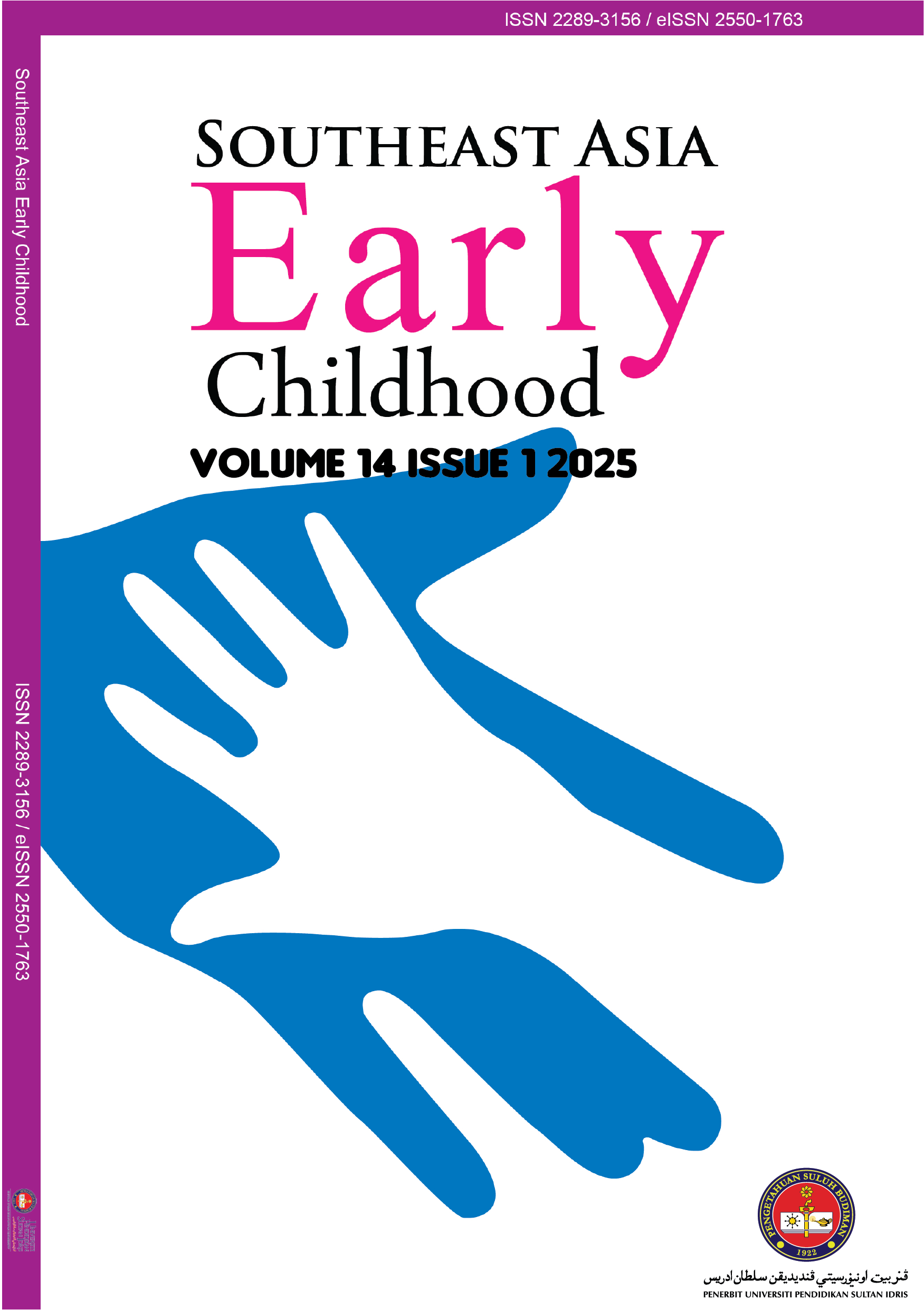A Comparative Study of Traditional Teaching Method and Semantic Radical Visual Mnemonic in Mandarin Character Recogniton among Malaysian Preschoolers
DOI:
https://doi.org/10.37134/saecj.vol14.1.10.2025Keywords:
Traditional Teaching Method, Semantic Radical, Visual Mnemonic, gender, preschoolAbstract
Preschoolers often struggle with recognizing Mandarin characters due to their complexity. This study compared the effectiveness of Traditional Teaching Method (TTM) and Semantic Radical and Visual Mnemonic (SRVM) approaches in improving Mandarin character recognition among Malaysian preschoolers, while also exploring age and gender effects. 58 children aged 5 and 6 were involved, with 31 in SRVM and 27 in TTM groups. Over two weeks, 25 characters were taught. Both methods showed positive results, with increased post-test scores in SRVM (t (30) = -6.75, p < .05) and TTM (t (27) = -7.79, p < .05) groups, indicating improved learning. However, there was no significant difference between SRVM and TTM groups (F(1,56) = 0.15, p = 0.70), possibly due to individual learning styles. Age-related differences were not significant (F(1,54) = 0.08, p = .78), suggesting both methods are effective for 5 and 6-year-olds. Gender differences were also insignificant (F(1,54) = 0.26, p = .61), indicating similar learning outcomes for males and females. The study suggests a holistic teaching approach focusing on personalized strategies to enhance Mandarin character learning for all preschoolers.
Downloads
References
Aquino, L. N., Mamat, N., & Che Mustafa, M. (2019). Levels of competence in the learning domains of kindergarten entrants. Southeast Asia Early Childhood Journal, 8(1), Article 5. https://doi.org/10.37134/saecj.vol8.no1.5.2019
Awla, H. A. (2014). Learning styles and their relation to teaching styles. International Journal of Language and Linguistics, 2(3), 241-245. https://doi.org/10.11648/j.ijll.20140203.23
Chang, L.-Y., Tang, Y.-Y., Lee, C.-Y., & Chen, H.-C. (2022). The effect of visual mnemonics and the presentation of character pairs on learning visually similar characters for Chinese-as-second-language learners. Frontiers in Psychology, 13, 783898. https://doi.org/10.3389/fpsyg.2022.783898
Chen, H. (2019). Preschoolers’ knowledge of Chinese characters: From radical awareness to character recognition. Journal of Early Childhood Literacy, 21(3), 388-412. https://doi.org/10.1177/1468798419846205
Fu, Y. 傅永和 (Ed.). (1989). Hanzi shuxing zidian 《汉字属性字典》. Beijing: Yuwen Chubanshe.
Lam, H. C. (2011). A critical analysis of the various ways for teaching Chinese characters. Electronic Journal of Foreign Language Teaching, 8, 51–70.
Li, M., Suiqing, C., & Wu, S. (2021). The development of preschool children’s awareness of semantic radicals in Chinese characters. Frontiers in Communication, 6. https://doi.org/10.3389/fcomm.2021.685573
Liu, N., Tong, W., & Yan, G. (2014). The development of Chinese orthographic awareness in preschool children. Psychological Development and Education, 5, 457-465. https://doi.org/10.16187/j.cnki.issn1001-4918.2014.05.015
Lu, J., Kalyuga, S., & Sweller, J. (2020). Altering element interactivity and variability in example‐practice sequences to enhance learning to write Chinese characters. Applied Cognitive Psychology, 34(4), 837–843. https://doi.org/10.1002/acp.3668
Mance, I., & Vogel, E. K. (2013). Visual working memory. Wiley Interdisciplinary Reviews: Cognitive Science, 4(2), 179-190. https://doi.org/10.1002/wcs.1219
McBride, C. (2016). Is Chinese special? Four aspects of Chinese literacy acquisition that might distinguish learning Chinese from learning alphabetic orthographies. Educational Psychology Review, 28(3), 523-549. https://doi.org/10.1007/s10648-015- 9318-2
Mustika, R. M., Anisaturrahmi, Elfiadi, & Imami, M. K. W. (2025). Validation of a story-based picture module for Early Childhood Students: A Study in a Kindergarten in Aceh. Southeast Asia Early Childhood Journal, 14(1), 48-57. https://doi.org/10.37134/saecj.vol14.1.4.2025
Paivio, A. (1986). Mental representations. New York: Oxford University Press. http://dx.doi.org/10.1093/acprof:oso/9780195066661.001.0001
Pengfei, C., Hsuanpo, W., & Crystal. (2018). Key-image picture-based approach: Teaching Chinese character via online distance learning to Chinese as foreign language learners. https://doi.org/10.17706/ijeeee.2019.9.3.186-194
Prescott, J. (2014). Teaching style and attitudes towards Facebook as an educational tool. Active Learning in Higher Education, 15(2), 117-128. https://doi.org/10.1177/ 1469787414527392
Qian, Y., Zhao, J., & Bi, H. (2013). The development of orthographic awareness in Chinese preschool children. Acta Psychologica Sinica, 45(1), 60-69. https://doi.org/10.3724/sp.j.1041.2013.00060
Rostan, N. N. A., Ismail, H., & Mohamad Jaafar, A. N. (2020). The use of multisensory technique in the teaching
open syllables reading skill for preschoolers from a teacher’s perspective. Southeast Asia Early Childhood Journal, 9(2), Article 11. https://doi.org/10.37134/saecj.vol9.no2.11.2020
Schurgin, M. W., & Brady, T. F. (2019). When "capacity" changes with set size: Ensemble representations support the detection of across-category changes in visual working memory. Journal of Vision, 19(3). https://doi.org/10.1167/19.5.3
Sung, K. Y. (2014). Novice learners’ Chinese-character learning strategies and performance. Electronic Journal of Foreign Language Teaching, 11(1), 39. Singapore. eflt.nus.edu.sg/v11n12014/sung.pd
Tsai, M. H., Chang, L. C., Chen, H. C., & Lin, C. L. (2021). Effects of key-image mnemonics on Chinese instruction for first-grade students’ achievement and interest toward Chinese learning. International Journal of Educational Research, 109, 101856.
Vaughn, S., Wanzek, J., Murray, C. S., & Roberts, G. (2012). Intensive interventions for students struggling in reading and mathematics: A practice guide. Portsmouth, NH: RMC Research Corporation, Center on Instruction. Retrieved from http://www.centeroninstruction.org/files/Intensive%20Interventions%20for%20Students%20Struggling%20in%20Reading%20%26%20Math.pdf
Wang, J., Zhang, J., & Hu, H. (2015). The developmental study of semantic radicals’ consistency awareness of primary school children. Journal of Psychological Science, 38(5), 1136-1140. https://doi.org/10.16719/j.cnki.1671-6981.2015.05.017
Yeh, S., Chou, W., & Ho, P. (2017). Lexical processing of Chinese sub-character components: Semantic activation of phonetic radicals as revealed by the Stroop effect. Scientific Reports, 7(1). https://doi.org/10.1038/s41598-017-15536-w
Zhang, J., & Zhang, Y. (2016). The time course of semantic radicals' semantic and syntax activation under radical priming paradigm. Acta Psychologica Sinica, 48(9), 1070-1081. https://doi.org/10.3724/SP.J.1041.2016.01070
Zhou, J. (2021). Engaging Stage 1 students in Western Sydney Mandarin classes through pictographic characters: A unit of work for Stage 1 children.
Downloads
Published
Issue
Section
License
Copyright (c) 2025 Tang Wan Chin, Phoon Hooi San

This work is licensed under a Creative Commons Attribution-NonCommercial-ShareAlike 4.0 International License.





